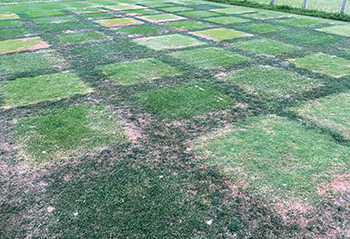Midwest cool-season fairway water requirements

Overview of the field study area showing differences in various cool-season fairway species when subject to two supplemental irrigation programs. (Photo: Cale Bigelow)
Fairways are some of the largest areas of irrigated golf course turf. Although regions like the Midwest, Mid-Atlantic and Northeast (where creeping bentgrass is widely used) are considered “humid,” acute drought can persist for weeks. Combine drought with water scarcity concerns, and efficient water use on courses is essential. This leads to the questions: How much water does creeping bentgrass need in the Midwest, and are there alternative grass species or cultivars that require significantly less water compared to creeping bentgrass?
A two-year field study was conducted in West Lafayette, Ind., on a silt-loam soil under a fixed-roof rain-out structure to examine the supplemental water needs of six potential fairway species: creeping bentgrass, colonial bentgrass, perennial ryegrass, Kentucky bluegrass (three cultivars), fine-leaf fescue (a blend or single species) and turf-type tall fescue (two cultivars). The grasses were seeded in Sept. 2016 and allowed to mature until the trial began in 2017. Once established, the grasses were maintained using two supplemental irrigation programs: irrigation three times per week at 80-percent evapotranspiration (ET) replacement using data from an on-site weather station, or a green color-threshold response approach. For the green color threshold, digital images determined the percentage of green turf. When an individual plot exceeded the threshold, water was applied. The green turf thresholds were 55 percent or 65 percent, and water applied at 0.25 inch or 0.3 inch for years 1 and 2, respectively.
For more than 75 days in year 1, the 80-percent ET turf received 10.9 total inches of water. By contrast, all species maintained using the green color threshold needed substantially less water. Creeping bentgrass required 4.5 inches and the fescues and one Kentucky bluegrass cultivar needed only about 3 inches of water. These results indicate that significant reductions in fairway irrigation needs could be achieved by maintaining alternative species and/or different approaches to determining supplemental irrigation needs.










